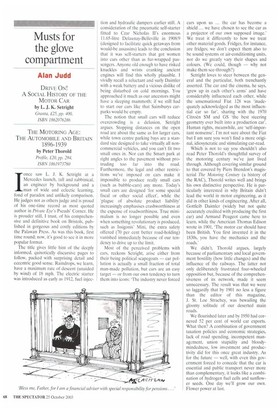Musts for the glove compartment
Alan Judd
DRIVE ON! A SOCIAL HISTORY OF THE MOTOR CAR by L. J. K. Setright Granta, £25, pp. 400, ISBN 1862076286 THE MOTORING AGE: THE AUTOMOBILE AND BRITAIN 1896-1939 by Peter Thorold Profile, £20, pp. 294. ISBN 1861973780 Ionce saw L. J. K. Setright at a Mercedes launch, tall and rabbinical, an engineer by background and a man of wide and eclectic learning, fond of paradox and unlikely comparison. He judges not as others judge and is proud of his one-time record as most quoted author in Private Eye's Pseuds' Corner. He is prouder still, I trust, of his comprehensive and definitive book on Bristols, published in gorgeous and costly editions by the Palawan Press. As was this book, first time round; now, it's good to see it in more popular format.
The title gives little hint of the deeply informed, quixotically discursive pages to follow, packed with surprising detail and eccentric good sense. Raindrops, we learn, have a maximum rate of descent (unaided by wind) of 18 mph. The electric starter was introduced as early as 1912, fuel injec
tion and hydraulic dampers earlier still. A consideration of the pneumatic self-starter fitted to Czar Nicholas II's enormous 11.65-litre Delaunay-Belleville in 1908/9 (designed to facilitate quick getaways from would-be assassins) leads to the conclusion that it was self-starters that got women into cars other than as fur-wrapped passengers. Anyone old enough to have risked knuckles and wrists cranking ancient engines will find this wholly plausible. I vividly recall a reluctant and surly Daimler with a weak battery and a vicious dislike of being disturbed on cold mornings. You approached it much as our ancestors might have a sleeping mammoth: if we still had to start our cars like that Sainsburys carparks would be empty.
The notion that small cars will reduce overcrowding is a delusion, Setright argues. Stopping distances on the open road are about the same as for larger cars, while town centre parking bays are a standard size designed to take virtually all noncommercial vehicles, and you can't fit two small ones in. Nor can the Smart park at right angles to the pavement without protruding too far into the road. Furthermore, the legal and other restrictions we've imposed on cars make it impossible to produce really small cars (such as bubble-cars) any more. Today's small cars are designed 'for some special fiscal or other social effect', while the 'plague of absolute product liability' increasingly emphasises crashworthiness at the expense of roadworthiness. True minimalism is no longer possible and even when something revolutionary is produced, such as Issigonis' Mini, the extra safety offered (70 per cent better road-holding) vanished immediately because of our tendency to drive up to the limit.
Most of the perceived problems with cars, reckons Setright, arise either from their being political scapegoats — car pollution is actually a small fraction of total man-made pollution, but cars are an easy target — or from our own tendency to turn them into icons: 'The industry never forced cars upon us ... the car has become a shield ... we have chosen to see the car as a projector of our own supposed image.' We treat it differently to how we treat other material goods. Fridges, for instance, are fridges; we don't expect them also to be sound systems or air-conditioning units, nor do we greatly vary their shapes and colours. (We could, though — why not make them see-through?) Setright loves to steer between the general and the particular, both trenchantly asserted. The car and the cinema, he says, 'grew up in each other's arms' and have considerably influenced each other, while the unsensational Fiat 128 was 'inadequately acknowledged as the most influential car so far', sharing with the 1970 Citroen SM and GS 'the best steering geometry ever built into a production car'. Human rights, meanwhile, are 'self-important nonsense'. I'm not sure about the Fiat but I am sure you won't find a more original, idiosyncratic and stimulating car-read.
Which is not to say you shouldn't also read Peter Thorold's thoughtful survey of the motoring century we've just lived through. Although covering similar ground to that covered by Piers Brendon's magisterial The Motoring Century (a history of the RAC), Thorold writes well and brings his own distinctive perspective. He is particularly interested in why Britain didn't lead the world in motor engineering, as it did in other kinds of engineering. After all, Gottleib Daimler (widely but not quite accurately credited with producing the first car) and Armand Peugeot came here to learn, while the American Thomas Edison wrote in 1901, 'The motor car should have been British. You first invented it in the 1830s, you have the mechanics and the roads.'
We didn't, Thorold argues, largely because of parliamentary and local government hostility (how little changes) and the influence of the railways. The latter not only deliberately frustrated four-wheeled opposition but, because of the comprehensiveness of its network, made it seem unnecessary. The result was that we were so laggardly that by 1901 no less a figure than the editor of this magazine, 1. St. Loe Strachey, was bewailing the gloomy solitude of our deserted main roads.
We flourished later and by 1950 had cornered 52 per cent of world car exports. What then? A combination of government taxation policies and economic strategies, lack of road spending, incompetent management, union stupidity and bloodymindedness, low investment and productivity did for this once great industry. As for the future — well, with even this government forced to concede that the car is essential and public transport never more than complementary, it looks like a combination of hydrogen fuel cells and sunflower seeds. One day we'll grow our own. Flower power at last.


































































































 Previous page
Previous page